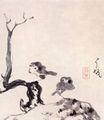- Bada Shanren
-
Bada Shanren (Chinese: 八大山人; Wade–Giles: Pata Shanjen; literally "Mountain Man of the Eight Greats", Gan: Pat-thai San-nin, ca. 1626—1705), born as Zhu Da (朱耷), was a Chinese painter of shuimohua and a calligrapher. He was of noble lineage, being a descendant of the Ming dynasty prince Zhu Quan. Art historians have named him as a leading painter of the period.
Bada Shanren, a purported child prodigy, began painting and writing poetry in his early childhood. About the year 1644,[citation needed] when the Ming emperor committed suicide and the Manchu army from the north attacked Beijing, the young Han man sought refuge in a Buddhist monastery. Because he was a Ming prince, the dynastic upheaval created a great amount of uncertainty for his position in society. As years passed and the Qing dynasty became more firmly established, there was less and less insecurity among the Qing regime about remaining Ming loyalties and possible future rebellions. Due to these more stable circumstances, after 40 years, Bada Shanren deemed it acceptable to leave the monastery and to re-enter day-to-day life among society.[1] In the aftermath of a nervous breakdown that could have been staged to avoid retribution for his family background, Zhu Da abandoned his monastic life and developed a career as a professional painter, adopting a series of descriptive pseudonyms, most notably Bada Shanren by which he is most often known today.[2] The stylized vertical writing of his pseudonym Bada Shanren (八大山人) looks like the characters for laugh (笑) and cry (哭), thus by signing his paintings he implied his confusion and feelings of grief for the fate of his country and home.[3]
His paintings feature sharp brush strokes which are attributed to the sideways manner by which he held his brush. In the 1930s, Chinese painter Zhang Daqian produced several forgeries of Bada Shanren's works. But they are easily spotted by the trained eye, because the modern copies were softer and rounder. Yale University scholar, Wang Fangyu, was a major collector of Bada Shanren paintings from the 1960s until his death in 1997.
-
Lotus and Birds (荷花小鸟图), Zhu Da, Shanghai Museum
-
Mynah Bird on an Old Tree, Zhu Da, Palace Museum, Beijing
References
- ^ Glaze, Anna. Landscapes, Tradition, and the Seventeenth-Century Art Market: A Different Side of Bada Shanren. Master's Thesis, University of California, Davis., June, 2008.
- ^ Stockard, Marilyn
- ^ China: five thousand years of history and civilization. Hong Kong: City University of Hong Kong Press. 2007. p. 761. ISBN 978-962-037-140-1. http://books.google.com/books?id=z-fAxn_9f8wC.
- Stokstad, Marilyn; Art History, 2011, 4th ed., ISBN 0205790941
External links
- Zhu Da and his Painting Gallery at China Online Museum
Categories:- 1626 births
- 1705 deaths
- Chinese painters
- Ming Dynasty painters
- Qing Dynasty painters
- Chinese calligraphers
Wikimedia Foundation. 2010.




